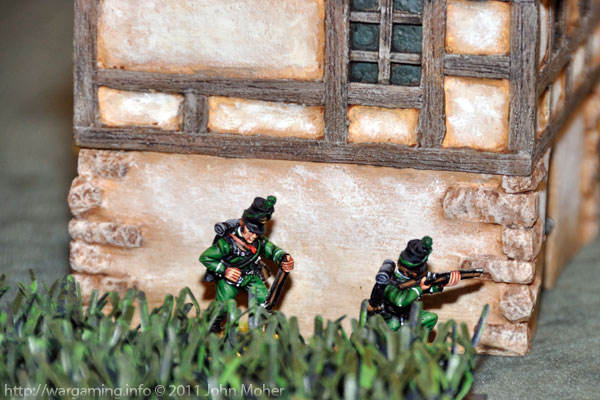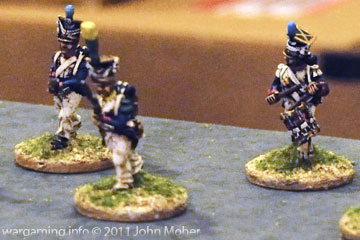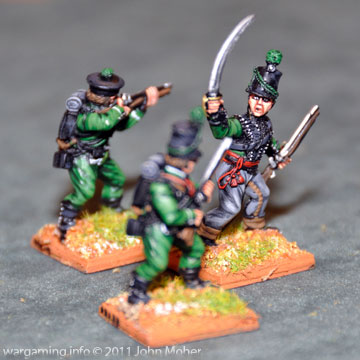
I’ve been giving some thought to skirmish gaming over the last year or so – it started with Fantasy, as I was looking for something to do with my collection of classic D&D (Dungeon’s & Dragons) RPG figures that I’ve collected over the years (some dating from the early 1980’s, others being more recent 2000 acquisitions after the release of 3rd Edition D&D tempted a (very) brief revisit to the P&P (Pen & Paper) RPG world), however the idea rapidly spread to Napoleonics (to use my assorted surplus figures from my Lasalle/SHAKO armies) and then it’s spread to thoughts of doing the F&IW (French & Indian War); and with the new releases by Empress Miniatures this year, the 19th Century New Zealand Wars!
I even have ACW (American Civil War) and Sci-Fi (e.g. Babylon 5, or Firefly, or Star Trek, or similar) in the back of my mind long-term. Ideally I was looking for something simple, fast, and suitable for fairly small forces (and if possible that could cover multiple periods), and that would be great for quick 1-2 hour games on small tables when there wasn’t opportunity to play full sized games, and perhaps incorporation into campaigns for minor actions…

My original thoughts were to use Sharpe Practice (from Too Fat Lardies) as I’d heard lots of good things about it, especially from the Kapiti Fusilier guys like Roly Hermans. I purchased these and several of the supplements and initial reading of the rules was promising, although I thought the layout of the PDF book isn’t that flash (great to read but may not be ideal for referencing during a game). However one thing that struck me is there’s a lot of focus on larger games so it’s not really a true ‘skirmish’ set, as it’s designed for you to run anything from 30-150 figures a side although they are intended to be at a 1:1 ratio – it’s kind of more a Company level type rule-set for use in games where more than a platoon or patrol a side is in action and you run the key characters and the plebs then follow them as appropriate…

However meanwhile at the AWC a couple of the guys had been trying out Song of Drums and Shakos (SDS) which is a Napoleonic variant of Song of Blades and Heroes (SBH) a fantasy skirmish gaming rule set. They had been finding them fast, easy to play and enjoyable, and they were much more focused towards games of 6-24 figures a side. What’s more they’d ideally suit and be easily adaptable to small scale actions of the early New Zealand Wars (Wairau Affray, Flagstaff War, Hutt Valley Campaign, & Wanganui Campaign 1843-1847) and consequently obviously F&IW games too, and they already had the fantasy stuff covered! So I quickly picked up both SBH and SDS and the latter’s expansion More Drums and Shakos (MDS). There are also ACW, Sci-Fi, Horror, Modern (20th Century onwards), and more – although admittedly the ACW variant has a lot more in common with Sharpe Practice than all the other Ganesha Games Skirmish rules as it’s aimed at 40-100 figs a side.

SDS looked promising so I soon organised a game with my regular opponent Kieran, who is a big fan of the rules, and set to work organising a force – I always only want to play historical games (as I can’t stand anachronistic opponents), and had hoped to use my Perry’s dismounted Dragoons (who are redundant from my Lasalle French Army), however as Kieran had only French ready to use (actually a Polish Regiment – the French 6th Ligne Regiment I believe) I opted to use some British – the choice being either the 95th Rifles or some Highlanders. I opted for the former and quickly worked out a ‘standard’ 400 point force (okay well actually it was 401 points). My force consisted of Lieutenant Richard Sharpe (of course), “Chosen Men” Patrick Harper, Daniel Hagman, and Francis Cooper, and Riflemen Isaiah Tongue, Ben Perkins, and Ben Harris (all being characters out of the books and/or the TV series) – Patrick Harper couldn’t be made an NCO due to lack of points! However all 7 men were rated with Élan, Light, & Rifle armed, while the 3 “Chosen Men” were also Marksmen and Lieutenant Sharpe was also obviously a Leader and rated Sword and Rifle armed.

Kieran meanwhile had a detachment of fairly average French Ligne Infantry, okay well actually they were Polish, so in real life a bit better than average, and his force included an Officer, NCO, Porte-Fanion (Standard Bearer), Drummer, 3 Grenadiers, 3 Voltigeurs, and 3 Fusiliers – 13 men in total! The 95th would be outnumbered nearly 2:1. However they had minimal special ratings, the Grenadiers obviously being rated Strong (so a mêlée bonus) and the Voltigeurs rated Light, but otherwise their muskets had less accuracy than the 95th Rifles Baker Rifles, while the Officer had only a Pistol & Sword, and the Drummer was unarmed (his benefit was the ability to transmit orders further than voice range). Quality-wise all the troops were similar with both sides Officers & the Polish NCO, Porte-Fanion, & Drummer all being better (3+) than the other troops on both sides (4+); however as the 95th Rifles all had Élan they effectively were one better again for motivation/initiative (i.e. they were easier to activate to take actions). All except the Polish Drummer (+1) had the same combat rating (+2) when it came to mêlée, shooting, and such.

The action would be an encounter, with two forces moving to occupy a small farm. A French detachment were out foraging for their regiment, and happened across a British patrol watching the flank of a larger British force. Lieutenant Sharpe on observing the approaching French deployed his men in 3 teams of two, each led by a “Chosen Man”, positioning himself with the centre team. The plan was to secure the farmyard’s flanks with two of the teams and then personally lead the central team to the decisive position as needed. The Polish meanwhile approached the farmyard either side of a low rise in 2 loose groups, heading for the farmhouse (led by Lieutenant Koslowski and Officer portant le fanion Gryzbowski) and the barn (led by Sergeant Adamicz) respectively… The 95th Riflemen had the advantage of the ground and were first to the buildings, quickly moving alongside both buildings as Sharpe moved into the centre of the farmyard.

Meanwhile the Poles advanced somewhat sporadically – not showing the same urgency as the Riflemen. In fact Kieran was being a bit more cautious, as the Polish were a bit harder to activate (not having the Élan of the Riflemen), so he wasn’t risking rolling 3 dice per figure for actions (as failure on 2 or more dice immediately handed initiative back to the enemy). Consequently the Poles were only conducting 1 or 2 actions to the 2-3 of each Rifleman. The Poles however had some readymade cover immediately in front of them, both groups had some convenient linear obstacles (stone walls or hedges) they could gain cover from once they advanced – the Riflemen’s only equivalent being to occupy the farm buildings if able. While Patrick Harper & Ben Perkins investigated the farmhouse on the left flank, “Chosen Man” Francis Cooper on the right began engaging Sergeant Adamicz’s group on the British right, from the side of the barn, his first shot knocking one of the Poles off his feet. In the centre Sharpe was uncharacteristically indecisive and led Hagman and Tongue forward somewhat cautiously (he was getting dreadful activation rolls despite only needing 2+ due to his Élan)…

There followed a period of intermittent fire and cautious manoeuvring – on the British left Harper & Perkins got into the farmhouse and Harper finally began sniping (very ineffectually) from the 1st floor window, supported by Perkins from the front doorway (also very ineffectually). On the British right Cooper was much more effective, his fire forcing the Polish off their feet or back a couple of times, but not able to get a telling hit. Harris was in support but only managed to get off one shot the whole time. Both groups of Poles continued to advance moving up close behind the stone wall and hedge respectively… The Poles were also sporadically returning fire once they got into range, but their muskets were not as accurate as the Baker Rifles – however out of the blue a Voltigeur (yeah that drunk one in the photo above) got a lucky shot off at “Chosen Man” Daniel Hagman, that ripped through the poor rifleman and instantly felled him with a serious wound! That being then promptly followed by one of the other Poles getting a near-miss on Isaiah Tongue that knocked him off his feet.

This seemed to impact Sharpe quite critically – despite repeated attempts to advance and engage the Poles he just refused to do so – losing all motivation and able to only fire off a sporadic shot at the closer group led by Lieutenant Koslowski (in fact activation rolls for Sharpe were pretty dreadful for the entire game – he seemed to be a magnet for 1’s on the dice). In fact things weren’t going that flash for the British generally, and the much vaunted 95th Riflemen weren’t hitting much with their rifles especially! This ineffectual firing and manoeuvring had now been going on for some time.
The Poles however were getting into a stronger position as the fight progressed, most of their men were in cover now, and many were able to snipe back (albeit at long range) at the British. What’s more most of the British were in the open or at least in a position that only provided cover from some of the enemy. About this time Patrick Harper abandoned his upstairs window to move downstairs to rejoin Perkins – the intent being to join up with Sharpe and Tongue for an assault on the Poles behind the stonewall.
Sharpe was still decidedly indecisive and numbers were starting to build up against the riflemen – on the right Cooper and Harris were in serious danger of being hit and in fact were dangerously close to being charged, so they began withdrawing to the rear of the barn… Harper finally emerged from the 1st floor into the farmhouse’s kitchen to join Perkins (obviously having been waylaid by some “Enlisted Man’s Shopping” in the farmhouse)…

It was by then apparent the Riflemen were going to struggle to overcome the Poles – with the ranges closed the Polish numbers would start to tell, and the Riflemen’s superior accuracy and motivation (although there had been little actual evidence of either so far in the game) were going to be neutralised, so there was no choice but to begin a withdrawal, at which point we called the game over, with a nominal winning draw to the Polish (as we agreed the Rifles would be able to make a fairly clean and prompt getaway from their current positions due to their Élan). As a first game of SDS it had been an interesting experience and highlighted the need for some planning in your actions, and the old maxims of concentration of force and simplicity! With the way the SDS mechanics work it was a key difference for the Riflemen to be able to throw 3 dice at times with a reasonable chance of getting 3 actions and not losing the initiative, but still highlighted the need not to rely on such things continuously, While Kieran was reduced to throwing 2 and often just 1 dice for actions to minimise the risk of losing the initiative and/or keeping his chaps close to their leaders to facilitate ‘group moves’ for similar reasons! So generally a positive first outing with some obvious subtle effects and in some respects a similar style of game to Crossfire with the initiative and variable bounds (which also augurs well). So I will be looking forward to another bash in the near future, and then hopefully a fantasy game or two with SBH…

Oh, and yes, I know the riflemen’s uniforms are too green. The figures are some pro-painted Foundry chaps from Dragon Painting Services in Hong Kong, and were an opportunity buy off EBay in a sale quite sometime ago – and that didn’t look quite so ‘green’ at the time (and in fact I never used them for my Lasalle 1815 British Army in the end because of the colour)… I plan to try and give them a wash to hopefully darken the green up at some stage (probably when I get around to also rebasing them at the same time). The French/Polish figures are Front Rank (I believe) and were painted by Kieran. The barn is from Warlord Games and the farmhouse from Ziterdes.

You should take a look at Vortex from Unified Theory Games as its a multi genre set and you can use it for just about anything you can imagine. I like Ganasha Games rules though and enjoyed seeing your battle report. For Napoleonic games I use 1/72 plastics.